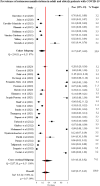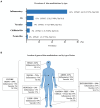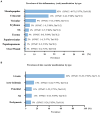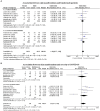Prevalence of skin manifestations in patients with COVID-19: a systematic review and meta-analysis
- PMID: 39234048
- PMCID: PMC11371801
- DOI: 10.3389/fmed.2024.1390775
Prevalence of skin manifestations in patients with COVID-19: a systematic review and meta-analysis
Abstract
Background: COVID-19 presents extrapulmonary manifestations that can aid in the diagnosis. Skin manifestations have been reported but their characteristics are not yet clear. Health professionals need information about its prevalence and main characteristics.
Methods: This systematic review followed the PRISMA criteria. The protocol was registered in the PROSPERO (number CRD42020193173). Seven electronic databases and the gray literature were searched independently by two researchers. Observational analytical studies that presented data on the prevalence of skin manifestations in patients aged 19 or older with COVID-19 were included. Prevalence estimates were synthesized through a meta-analysis using random-effects models. Association meta-analysis and comparisons were performed for individual characteristics.
Results: We included 31 studies with 10,934 patients, of which 10,121 tested positive for COVID-19. The general prevalence of skin manifestations was 29% (95% CI: 17.0-43.0; I2: 99%), the most in Africa, with a mean duration between 7 and 9 days and the most frequently affecting feet+hands (75%) and the trunk (71%). Patients with mild/moderate COVID-19 had more of chilblain-like+pernio-like lesions (97%) and inflammatory lesions (86%) than patients with severe or critical COVID-19. Manifestations of vascular origin were only in elderly patients and were significant with the severity of COVID-19 (p = 0).
Conclusion: The global prevalence of skin manifestations is similar to other signs and symptoms of COVID-19. Skin assessment should be considered when investigating and diagnosing COVID-19 in adult and elderly patients.Systematic review registration: PROSPERO, identifier CRD42020193173, https://www.crd.york.ac.uk/prospero/display_record.php?ID=CRD42020193173.
Keywords: COVID-19; adult; aged; meta-analysis; skin manifestation; systematic review.
Copyright © 2024 Aguiar, Ferreira, De Luca Canto, Guerra and Reis.
Conflict of interest statement
The authors declare that the research was conducted in the absence of any commercial or financial relationships that could be construed as a potential conflict of interest.
Figures







References
-
- Mohan BS, Nambiar V. COVID-19: an insight into SARS-CoV-2 pandemic originated at Wuhan City in Hubei Province of China. J Infect Dis Epidemiol. (2020) 6:146. doi: 10.23937/2474-3658/1510146 - DOI
Publication types
LinkOut - more resources
Full Text Sources

